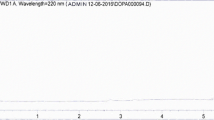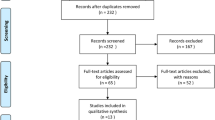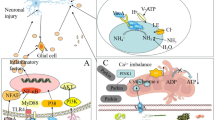Abstract
The presence of Helicobacter pylori (HP) in the gastrointestinal tract may limit the absorption of levodopa. The objectives of this study were to investigate whether HP infection may affect the clinical response to levodopa as well as levodopa dose requirement in patients with Parkinson’s disease (PD) as well as to investigate whether HP infection may affect plasma levels of vitamin B12, folic acid, and homocysteine. Seventy-five patients with PD diagnosed at least 4 years ago were included. Symptom fluctuations were assessed by UPDRS-IV and the WOQ9 wearing-off-scale. Plasma levels of vitamin B12, folic acid, and homocysteine were analyzed. Screening for HP was performed with a 13C-labeled urea breath test (Diabact UBT). A propensity-matched analysis was made where each patient in the HP-infected group was matched with one patient in the non-infected group with respect to age and gender. Of the 75 included patients, 20 were HP infected (27 %). Median Hoehn & Yahr scores were 3 in both HP infected patients and the matched group (n = 20). HP-infected patients had decreased “complications of therapy” with average total UPDRS-IV score of 4.8 ± 3.0 vs. 7.7 ± 3.8 (p < 0.05), despite no significant difference in levodopa equivalent dose. Wearing-off and sleep disturbance were significantly less common in the HP group (p < 0.05). There were no differences regarding vitamin B12, folic acid, or homocysteine values. HP infection in patients with PD may result in a decreased occurrence of symptom fluctuations according to this small study. This finding may be due to altered absorption of levodopa in the gastrointestinal tract in patients with HP infection, but further studies are required.
Similar content being viewed by others
References
Lewitt PA (2008) Levodopa for the treatment of Parkinson’s disease. N Engl J Med 359(23):2468–2476. doi:10.1056/NEJMct0800326
Nyholm D, Lennernas H (2008) Irregular gastrointestinal drug absorption in Parkinson’s disease. Expert Opin Drug Metab Toxicol 4(2):193–203. doi:10.1517/17425255.4.2.193
Nyholm D, Karlsson E, Lundberg M, Askmark H (2010) Large differences in levodopa dose requirement in Parkinson’s disease: men use higher doses than women. Eur J Neurol 17(2):260–266. doi:10.1111/j.1468-1331.2009.02866.x
Pierantozzi M, Pietroiusti A, Brusa L, Galati S, Stefani A, Lunardi G, Fedele E, Sancesario G, Bernardi G, Bergamaschi A, Magrini A, Stanzione P, Galante A (2006) Helicobacter pylori eradication and l-dopa absorption in patients with PD and motor fluctuations. Neurology 66(12):1824–1829. doi:10.1212/01.wnl.0000221672.01272.ba
Niehues M, Hensel A (2009) In-vitro interaction of l-dopa with bacterial adhesins of Helicobacter pylori: an explanation for clinical differences in bioavailability? J Pharm Pharmacol 61(10):1303–1307. doi:10.1211/jpp/61.10.0005
Fiddian-Green RG (2007) Helicobacter pylori eradication and l-dopa absorption in patients with PD and motor fluctuations. Neurology 68(13):1085. doi:10.1212/01.wnl.0000260440.07107.99 author reply 1085
Lyte M (2010) Microbial endocrinology as a basis for improved L-DOPA bioavailability in Parkinson’s patients treated for Helicobacter pylori. Med Hypotheses 74(5):895–897. doi:10.1016/j.mehy.2009.11.001
Nielsen HH, Qiu J, Friis S, Wermuth L, Ritz B (2012) Treatment for Helicobacter pylori infection and risk of Parkinson’s disease in Denmark. Eur J Neurol 19(6):864–869. doi:10.1111/j.1468-1331.2011.03643.x
Lacy BE, Rosemore J (2001) Helicobacter pylori: ulcers and more: the beginning of an era. J Nutr 131(10):2789S–2793S
Brown LM (2000) Helicobacter pylori: epidemiology and routes of transmission. Epidemiol Rev 22(2):283–297
Pounder RE, Ng D (1995) The prevalence of Helicobacter pylori infection in different countries. Aliment Pharmacol Ther 9(Suppl 2):33–39
Storskrubb T, Aro P, Ronkainen J, Sipponen P, Nyhlin H, Talley NJ, Engstrand L, Stolte M, Vieth M, Walker M, Agreus L (2008) Serum biomarkers provide an accurate method for diagnosis of atrophic gastritis in a general population: the Kalixanda study. Scand J Gastroenterol 43(12):1448–1455. doi:10.1080/00365520802273025
Graham DY, Adam E, Reddy GT, Agarwal JP, Agarwal R, Evans DJ Jr, Malaty HM, Evans DG (1991) Seroepidemiology of Helicobacter pylori infection in India. Comparison of developing and developed countries. Dig Dis Sci 36(8):1084–1088
Graham DY, Lew GM, Klein PD, Evans DG, Evans DJ Jr, Saeed ZA, Malaty HM (1992) Effect of treatment of Helicobacter pylori infection on the long-term recurrence of gastric or duodenal ulcer. A randomized, controlled study. Ann Intern Med 116(9):705–708
Kusters JG, van Vliet AH, Kuipers EJ (2006) Pathogenesis of Helicobacter pylori infection. Clin Microbiol Rev 19(3):449–490. doi:10.1128/CMR.00054-05
Lehours P, Yilmaz O (2007) Epidemiology of Helicobacter pylori infection. Helicobacter 12(Suppl 1):1–3. doi:10.1111/j.1523-5378.2007.00541.x
Malaty HM (2007) Epidemiology of Helicobacter pylori infection. Best Pract Res Clin Gastroenterol 21(2):205–214. doi:10.1016/j.bpg.2006.10.005
Xia HH, Talley NJ (1997) Natural acquisition and spontaneous elimination of Helicobacter pylori infection: clinical implications. Am J Gastroenterol 92(10):1780–1787
Roosendaal R, Kuipers EJ, Buitenwerf J, van Uffelen C, Meuwissen SG, van Kamp GJ, Vandenbroucke-Grauls CM (1997) Helicobacter pylori and the birth cohort effect: evidence of a continuous decrease of infection rates in childhood. Am J Gastroenterol 92(9):1480–1482
Haruma K, Okamoto S, Kawaguchi H, Gotoh T, Kamada T, Yoshihara M, Sumii K, Kajiyama G (1997) Reduced incidence of Helicobacter pylori infection in young Japanese persons between the 1970s and the 1990s. J Clin Gastroenterol 25(4):583–586
Parsonnet J, Blaser MJ, Perez-Perez GI, Hargrett-Bean N, Tauxe RV (1992) Symptoms and risk factors of Helicobacter pylori infection in a cohort of epidemiologists. Gastroenterology 102(1):41–46 [pii]:S0016508592000362
Telaranta-Keerie A, Kara R, Paloheimo L, Harkonen M, Sipponen P (2010) Prevalence of undiagnosed advanced atrophic corpus gastritis in Finland: an observational study among 4,256 volunteers without specific complaints. Scand J Gastroenterol 45(9):1036–1041. doi:10.3109/00365521.2010.487918
Rees K, Stowe R, Patel S, Ives N, Breen K, Clarke CE, Ben-Shlomo Y (2011) Helicobacter pylori eradication for Parkinson’s disease. Cochrane Database Syst Rev (11):CD008453. doi:10.1002/14651858.CD008453.pub2
Hoehn MM, Yahr MD (1967) Parkinsonism: onset, progression and mortality. Neurology 17(5):427–442
Movement Disorder Society Task Force on Rating Scales for Parkinson’s Disease (2003) The Unified Parkinson’s Disease Rating Scale (UPDRS): status and recommendations. Mov Disord 18(7):738–750. doi:10.1002/mds.10473
Stacy MA, Murphy JM, Greeley DR, Stewart RM, Murck H, Meng X (2008) The sensitivity and specificity of the 9-item Wearing-off Questionnaire. Parkinsonism Relat Disord 14(3):205–212. doi:10.1016/j.parkreldis.2007.07.013
Tomlinson CL, Stowe R, Patel S, Rick C, Gray R, Clarke CE (2010) Systematic review of levodopa dose equivalency reporting in Parkinson’s disease. Mov Disord 25(15):2649–2653. doi:10.1002/mds.23429
Evrengul H, Tanriverdi H, Kuru O, Enli Y, Yuksel D, Kilic A, Kaftan A, Kirac S, Kilic M (2007) Elevated homocysteine levels in patients with slow coronary flow: relationship with Helicobacter pylori infection. Helicobacter 12(4):298–305. doi:10.1111/j.1523-5378.2007.00505.x
Hu XW, Qin SM, Li D, Hu LF, Liu CF (2013) Elevated homocysteine levels in levodopa-treated idiopathic Parkinson’s disease: a meta-analysis. Acta Neurol Scand 128(2):73–82. doi:10.1111/ane.12106
Pietroiusti A, Galante A, Magrini A, Bergamaschi A (2008) Helicobacter pylori interference with micronutrients and orally administered drugs: a new mechanism explaining its role in extragastric disorders. Mini Rev Med Chem 8(2):135–141
Marino MC, de Oliveira CA, Rocha AM, Rocha GA, Clementino NC, Antunes LF, Oliveira RA, Martins AS, Del Puerto HL, D’Almeida V, Galdieri L, Pedroso ER, Cabral MM, Nogueira AM, Queiroz DM (2007) Long-term effect of Helicobacter pylori eradication on plasma homocysteine in elderly patients with cobalamin deficiency. Gut 56(4):469–474. doi:10.1136/gut.2006.095125
Sekhon J (2011) Multivariate and propensity score matching software with automated balance optimization: the matching package for R. J Stat Softw 42:1–52
Fahn S, Oakes D, Shoulson I, Kieburtz K, Rudolph A, Lang A, Olanow CW, Tanner C, Marek K (2004) Levodopa and the progression of Parkinson’s disease. N Engl J Med 351(24):2498–2508. doi:10.1056/NEJMoa033447
Stocchi F, Rascol O, Kieburtz K, Poewe W, Jankovic J, Tolosa E, Barone P, Lang AE, Olanow CW (2010) Initiating levodopa/carbidopa therapy with and without entacapone in early Parkinson disease: the STRIDE-PD study. Ann Neurol 68(1):18–27. doi:10.1002/ana.22060
Nyholm D, Askmark H, Aquilonius SM (2011) Stalevo reduction in dyskinesia evaluation in Parkinson’s disease results were expected from a pharmacokinetic viewpoint. Ann Neurol 69(2):424. doi:10.1002/ana.22257 author reply 425
Wong WM, Lam SK, Lai KC, Chu KM, Xia HH, Wong KW, Cheung KL, Lin SK, Wong BC (2003) A rapid-release 50-mg tablet-based 13C-urea breath test for the diagnosis of Helicobacter pylori infection. Aliment Pharmacol Ther 17(2):253–257 [pii]:1417
Kokkola A, Kosunen TU, Puolakkainen P, Sipponen P, Harkonen M, Laxen F, Virtamo J, Haapiainen R, Rautelin H (2003) Spontaneous disappearance of Helicobacter pylori antibodies in patients with advanced atrophic corpus gastritis. APMIS 111(6):619–624
Salomaa-Rasanen A, Kosunen TU, Mattila J, Sarna S, Rautelin H (2004) Age-dependent accuracy of Helicobacter pylori antibody assays for adults, with special emphasis on atrophic gastritis. Clin Diagn Lab Immunol 11(6):1185–1188. doi:10.1128/CDLI.11.6.1185-1188.2004
Graham DY, Opekun AR, Yamaoka Y, Osato MS, el-Zimaity HM (2003) Early events in proton pump inhibitor-associated exacerbation of corpus gastritis. Aliment Pharmacol Ther 17(2):193–200
Murakami K, Sato R, Okimoto T, Watanabe K, Nasu M, Fujioka T, Kodama M, Kagawa J (2003) Influence of anti-ulcer drugs used in Japan on the result of 13C-urea breath test for the diagnosis of Helicobacter pylori infection. J Gastroenterol 38(10):937–941. doi:10.1007/s00535-003-1176-x
Varis K, Sipponen P, Laxen F, Samloff IM, Huttunen JK, Taylor PR, Heinonen OP, Albanes D, Sande N, Virtamo J, Harkonen M (2000) Implications of serum pepsinogen I in early endoscopic diagnosis of gastric cancer and dysplasia. Helsinki Gastritis Study Group. Scand J Gastroenterol 35(9):950–956
Drake IM, Mapstone NP, Schorah CJ, White KL, Chalmers DM, Dixon MF, Axon AT (1998) Reactive oxygen species activity and lipid peroxidation in Helicobacter pylori associated gastritis: relation to gastric mucosal ascorbic acid concentrations and effect of H pylori eradication. Gut 42(6):768–771
Lee WY, Yoon WT, Shin HY, Jeon SH, Rhee PL (2008) Helicobacter pylori infection and motor fluctuations in patients with Parkinson’s disease. Mov Disord 23(12):1696–1700. doi:10.1002/mds.22190
Salim AS (1993) The relationship between Helicobacter pylori and oxygen-derived free radicals in the mechanism of duodenal ulceration. Intern Med 32(5):359–364
Lahner E, Annibale B, Delle Fave G (2009) Systematic review: Helicobacter pylori infection and impaired drug absorption. Aliment Pharmacol Ther 29(4):379–386. doi:10.1111/j.1365-2036.2008.03906.x
Dixon M (1996) Pathological consequences of Helicobacter pylori infection. Scand J Gastroenterol Suppl 215:21
Acknowledgments
Kibion AB, Solvay Pharmaceuticals, and Uppsala University are acknowledged for support. The authors thank Marcus Thuresson, Statisticon AB, Uppsala, Sweden, for statistical analyses. The Diabact UBT kits including analyses were provided by Kibion AB. A grant for laboratory analyses was provided by Solvay Pharmaceuticals. A postdoc grant from Uppsala University was used.
Author information
Authors and Affiliations
Corresponding author
Rights and permissions
About this article
Cite this article
Rahne, KE., Tagesson, C. & Nyholm, D. Motor fluctuations and Helicobacter pylori in Parkinson’s disease. J Neurol 260, 2974–2980 (2013). https://doi.org/10.1007/s00415-013-7089-6
Received:
Revised:
Accepted:
Published:
Issue Date:
DOI: https://doi.org/10.1007/s00415-013-7089-6




